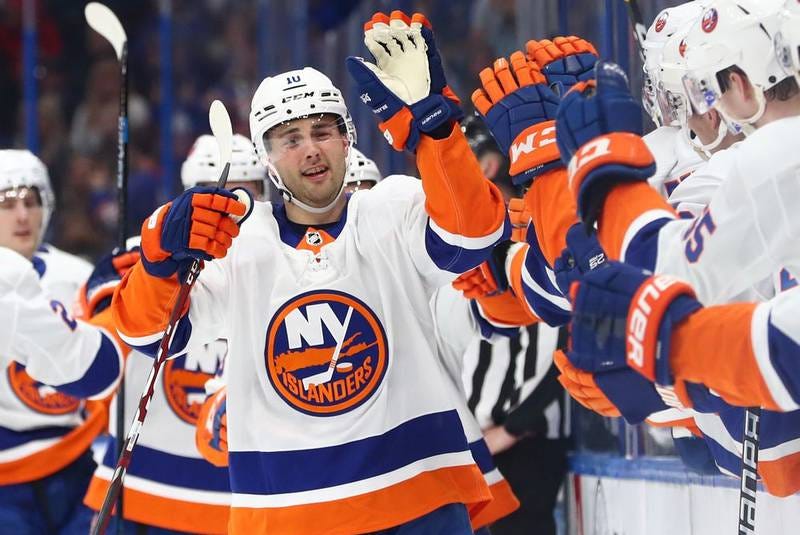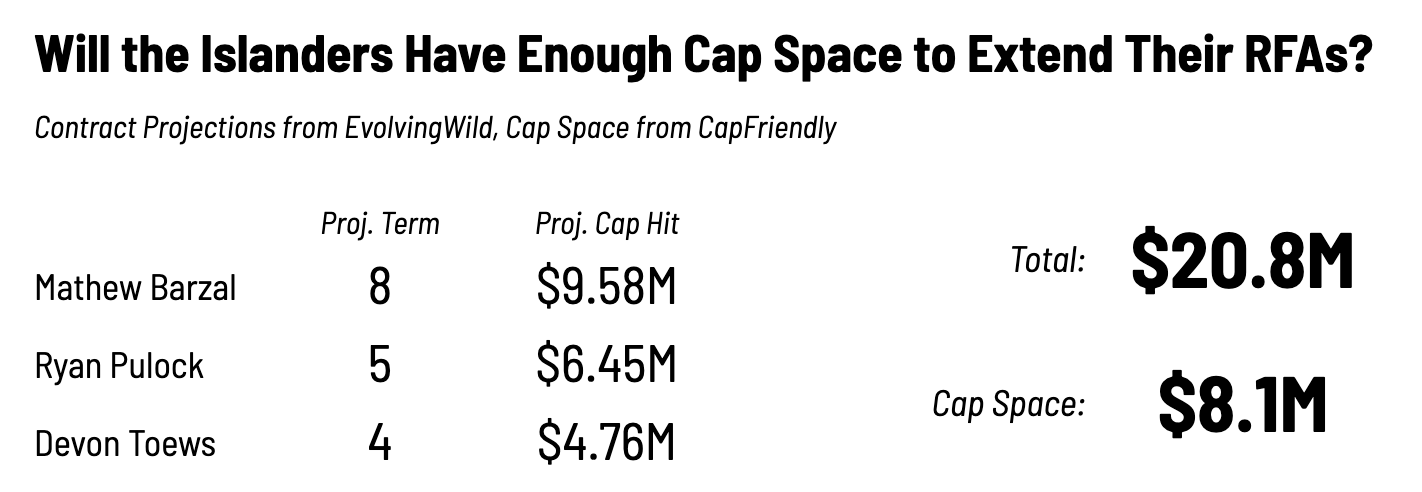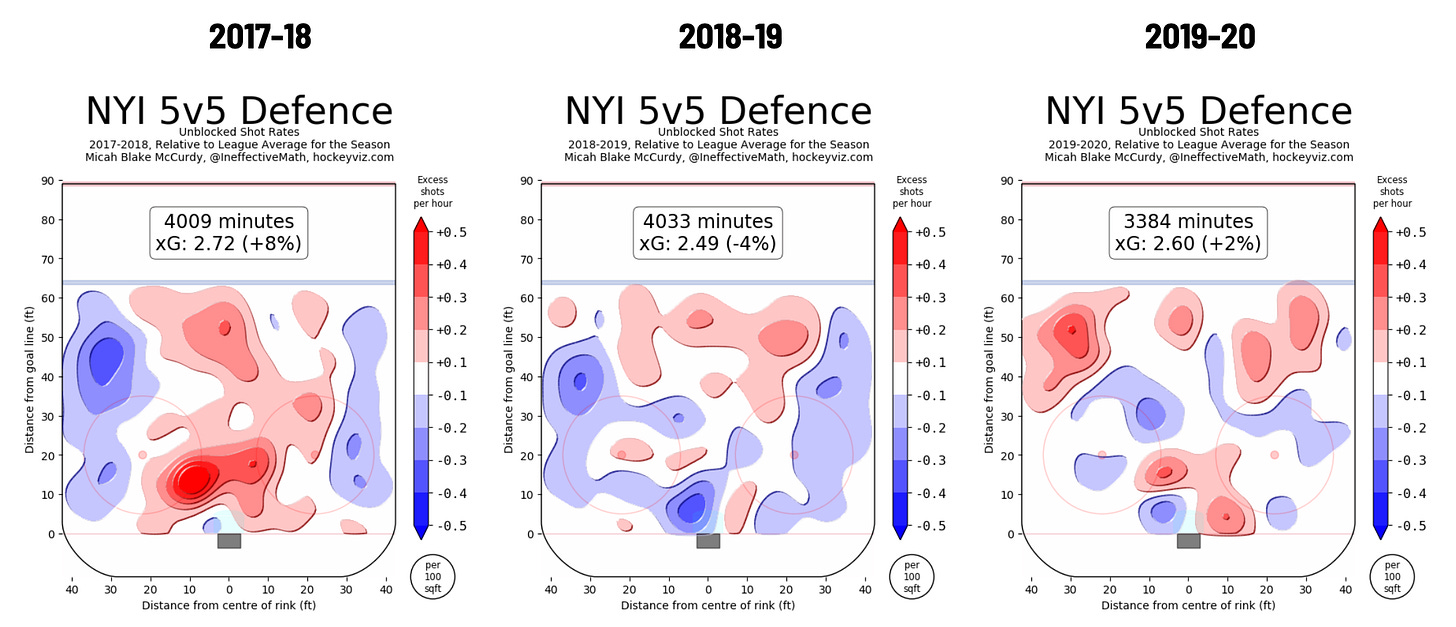Breaking Down The Islanders' Cap Nightmare
Searching for stability, the Isles appear doomed for stagnation.

People have been justifiably critical of the Toronto Maple Leafs’ grand roster building strategy ever since Lou Lamoriello left. In a flat cap environment, paying your top players huge money and trying to plug the holes with entry-level and league-minimum deals leaves you in a straitjacket that makes every contract negotiation a borderline existential crisis. This has led plenty of Leafs fans to yearn for the return of their former GM, but what Lamoriello has done in New York has arguably been even worse.
The Islanders’ “plan” is essentially the inverse of the Leafs’: lock up the depth and the middle six, and then… uh… figure it out somehow. Lou was brought on to provide stability and legitimacy to a franchise that desperately needed it, and he’s certainly changed the culture of the team. Recruiting Barry Trotz and Mitch Korn to lock down the team defence and goaltending - which had been liabilities for years - was a smart move that has hugely paid off, as the Isles have qualified for the playoffs in two straight seasons. But their contract situation means that stability could quickly turn into stagnation, condemning the organization to diminishing returns and locking in declining secondary players for years to come.
The Islanders’ best forward and two best defencemen are up for restricted free agency this summ- well, autumn I guess - and there are legitimate reasons to be concerned about their ability to fit them under the cap. Toews and Pulocks’ ages mean that they can no longer be bridged, meaning if Lou wants them to be a part of the team moving forward he’s going to have to give them some term. Barzal could theoretically be given a 2-year bridge deal, but considering he’s the team’s franchise forward that wouldn’t be an ideal option.

(Update: A previous version of this article mis-stated the Islander’s projected 2020-21 cap space as $15.5M, leaving out Cizikas, Pelech, and Sorokin)
According to EvolvingWild’s contract projections (which have been startlingly accurate in the past), these three should cost more than double what the team currently has to give them. And that’s assuming that they allows all their UFAs to walk and can fill all remaining roster spots with ELCs. If the team even wants to pretty much bring back anything resembling the current roster (which isn’t a top-tier contender), they’ll have to move out significant salary in an environment where that will be incredibly expensive. Actually improving the roster will be essentially impossible.
In this piece I’m going to break down each of the Islanders’ worst contracts - some of which are bad all on their own and some of which are regrettable within the context of the team’s overall cap situation. I’m going to use analytics to analyze these deals, specifically a Wins Above Replacement projection using an age curve that will provide an estimate for how the player in question is expected to perform relative to their contract. Before that, though, I’m going to briefly address the notion that the Islanders are a singularly special team that analytics simply do not apply to because they outperformed peoples’ expectations in 2018-19.
Sidebar: The Islanders are Not an Analytics “Exception”
I often see Islanders fans scoff at analytics in general, arguing that their defensive system is an anomaly that confounds the models currently out there. This piece (written about two weeks before the Isles got swept by the analytical darling Hurricanes) is a good example. Most of the time this is based on bad information (like the incorrect assumption that Corsi is still considered the gold standard of hockey advanced stats), but some even say the same about more sophisticated models like expected goals. I don’t think it’s a very strong argument, to be honest. Firstly, nobody has ever presented any actual evidence that these models systematically overrate the quality of shots that the Islanders’ goalies face. Secondly, it’s possible to come up with a pretty straightforward narrative about the Isles using analytics:
Barry Trotz and Mitch Korn have made a huge difference for the Islanders.
In 2017-18, the team was a disaster defensively; only the Rangers were worse at preventing quality chances, and only the Sens were worse at keeping the puck out of the net. Sure, they scored a lot of goals, but their below-average expected goal generation suggested that it probably wasn’t going to be sustainable.
All of that changed under the new system in 2018-19. Thanks to Trotz, the Isles suddenly became the league’s 5th best team at preventing quality chances against, leapfrogging 25 teams without appreciably changing their blueline personnel. While they didn’t score as many goals, the ones they did get were more sustainable and less a product of puck luck. Their xGF% rank (13th) was lower than their standings position (5th), but this was because of the league-best goaltending (in terms of goals saved above expected) they got from Robin Lehner and Thomas Greiss. It really seems like those two got a lot out of new goalie coach Mitch Korn, who had previously done superb work in Washington and Nashville.
Things slipped a bit in 2019-20. The team defence and team offence both fell off by a decent margin, leading to a proportionate dip both in xGF% rank and standings position. The biggest issue defensively is that while they maintained their lockdown over much of the defensive zone, they started to allow significantly more chances right in front of the net - a huge change from the year before. However, despite the departure of Robin Lehner their goaltending remained quite strong, allowing them to mostly weather this change. They had tremendous trouble scoring goals, finishing, and playing the powerplay, 26th in the league in all three categories.


Hockey analytics isn’t based on the principle that whoever “Corsis” the most is automatically going to win. It’s based on the idea that controlling play - generating quality chances and preventing your opponent from doing the same - puts you in a much better position to win than relying on your goalie and shooters to bail you out. That’s just intuitive common sense. It doesn’t mean that a team that gets outpossessed can’t win. If you get excellent goaltending, you can absolutely outperform your possession numbers, which is what the Islanders have done. Isles fans furious over people saying that their 2018-19 success was unsustainable have been proven wrong - their PDO (shooting% + save%) even regressed exactly to 100 this year.
With all of this in mind, let’s take a look at some of the players that the Islanders are committed to for the next several years.
Defencemen
This is where I really feel for Lou. He’s not responsible for either of the absolute anchors pinning down his defensive group, as they were signed to gigantic extensions by Garth Snow prior to the 2015-16 season. But he’s got to deal with them now.
Johnny Boychuk

When the Islanders acquired Johnny Boychuk, he was a legitimate top-pairing defenceman worth around six million dollars. He was also 30. At this point, we have a pretty good sense of how seven-year extensions for players over 30 tend to go, and he’s no exception. Boychuk has declined in each year of this deal, leaving him below-replacement level in the past three seasons. Even in a sheltered third-pairing role he hugely struggled this season, playing brutal hockey at both ends of the ice and even on the penalty kill. Barring a miraculous comeback at age 36, this is essentially dead cap space.
Nick Leddy

You can’t really blame Garth Snow for the baffling way this one has gone. Nick Leddy, acquired at 23, had gotten better in each of his NHL seasons by the time this was signed, and was spectacular for the Islanders in 2014-15. He should have been a safe bet to be worth a contract that paid him like a #3 defenceman. But somethings things just don’t work out. Like Boychuk, he’s steadily declined in each of the past four seasons despite being much younger. Leddy is an excellent transition player who uses his excellent skating to enter his opponents’ zone with possession of the puck more than almost any other defenders in the league. But he’s a liability everywhere else. He’s been in the bottom 30% of blueliners defensively by RAPM for the past five seasons and his offensive contributions have almost totally dried up, especially on the powerplay. This contract might be movable because of how flashy his skillset is, but it’s not a guarantee by any means.
Forwards
Unlike the dubious defensive duo, most of these contracts are Lou’s and most of these players are okay middle-six contributors. The issue here is mainly with their ceilings, their ages, and their term. Not pictured is Andrew Ladd, who didn’t play enough this season to have a contract card but will cost the Isles $4.5M in dead cap for the next three seasons if he’s stuffed in the minors again. Also not here is Casey Cizikas, who’s a great third line centre making reasonable third line centre money. Too bad he’s not the third line centre anymore…
Brock Nelson

Brock Nelson had a really great season that I think has justifiably increased hopes that this deal will actually look okay. At the time it was signed, people had very understandable issues with it - it was $1.6M richer and two years longer than projected market price, it stretched through his early thirties, he had only hit 50 points once, etc. I don’t know if the Islanders are completely out of the woods on this one, especially with a flat cap, but at the very least Nelson is projected to provide strong second line performance for most of the deal.
Jordan Eberle

Jordan Eberle did the Islanders a favour this year by living up to his new contract, which was by no means a guarantee after a really rough 2018-19 campaign. Like Nelson, it’s hard to complain about having a guy of his calibre in your top six, even if he is a little overpaid; however, as he hits his thirties don’t be surprised if he starts to noticeably decline in the next few seasons.
Leo Komarov

Leo Komarov is a decent bottom six forward. But is he really a guy you need to lock up for four years until he’s 35 with a no-trade clause when you have three other right wings making over $3.5M a year? I would say probably not. This kind of deal doesn’t look too bad when you have a lot of cap space, but when you don’t it’s a headscratcher.
Cal Clutterbuck

This is another Garth Snow legacy (although I have little doubt that Lou wouldn’t have done the same). As one might expect from a fourth liner who plays the way he does, Clutterbuck has declined steadily as he’s entered his thirties. Despite whatever grit/leadership he might provide, his actual on-ice impact is pretty replaceable.
Anders Lee

Remember that thing I said earlier about how signing 30 year olds to long term contracts doesn’t usually work out? Anders Lee is a strong goal and scoring chance driver despite some defensive deficiencies, definitely a guy you’d be happy to have in your top six. But unless he goes back to shooting 18 or 19% again like he did in ‘17 and ‘18, he’s not a $7M player. As he hits the point in a player’s career where the decline really starts to get going, it’s unlikely that this deal is going to look very pretty; he already underperformed it in year one. Would it have been tough for the Isles to let their captain walk for the second year in a row? Yes, but three of the closest comparables to this deal are Kyle Okposo, Bobby Ryan, and Ryan Callahan. Sometimes you have to make tough choices.
Josh Bailey

And yet another okay second-liner locked up for most of his early thirties. Josh Bailey is a very talented passer, but is otherwise relatively ineffective. He’s poor defensively, not a great driver of goals or scoring chances, and his production has really taken a hit since the powerplay has dried up. He’s at the point in his career where he’s very unlikely to get any better, and will probably decline over the next four seasons.
Jean-Gabriel Pageau

I have no idea what on earth possessed the Islanders to make this move. I think Jean-Gabriel Pageau will be a better player than the WAR model (weighed down by a hideous 2019 season) projects, but not by that much. To be worth his deal, Pageau would have to replicate his 2019-20 performance where his numbers were juiced thanks to playing top line minutes. He’s a below-average offensive player and only a bit better than average defensively as well, by no means a guy you would ever need to trade a 1st round pick for and then lock up for his early thirties - especially considering the the Islanders already have Casey Cizikas, who’s one of the best third line centres in the league and maybe the best defensively.
Conclusion
You might have noticed some things that all of these contracts have in common:
None of these players is a star, or even someone you could trust to consistently drive a top line/pairing.
None of these players has scored 30 goals or 55 points in each of the past two seasons.
They all expire when the player is in his 30s.
Each of these deals, totalling 46.5 million in cap for each of the next two seasons with many stretching well beyond that, locks in a stretch of years when the signed player is almost certainly going to decline. It’s been repeatedly shown that 30-33 is when the most dramatic regression starts to take place, and Isles have thirty-seven seasons of 30+ hockey locked up over the next six years, the most in the NHL. Even worse, not a single one of those players is a top player even now.
All of this is going to make it very difficult for the Islanders to get better. Their prospect pool is unexceptional, ranked 24th in the league by Scott Wheeler of The Athletic, and doesn’t contain any guaranteed top-line-calibre players. At least for the next two seasons, they’ll essentially have to make do with what they have in the system already unless they can somehow find a way to unload some of these deals - no guarantee in a league where cap space will be more scarce than ever.
Barry Trotz and Mitch Korn have done a very good job of wringing every bit of success possible out of a pretty mediocre lineup, but as these guys get older it’s going to be harder and harder to keep this group competitive. Does this team, as it’s currently constructed, have a serious chance at winning the Cup? I think it’s a longshot, and that’s not a good sign for a organization that apparently thinks it’s in win-now mode. The Islanders will have plenty of stability in the next few seasons, but can it translate into a championship before it sours into stagnation? This might be the best chance they get.



